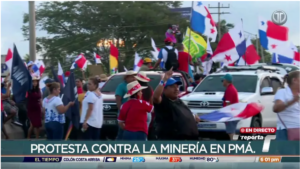Never before in his 12 years as a news cameraman had Victor Rivas felt threatened while doing his job. The first time came on Oct. 23, 2023 while broadcasting for the Panamanian media outlet Telemetro Reporta, as he told LatAm Journalism Review (LJR).
“That day I went to cover one of the protests... When the riot police arrived and were getting ready to suppress, the protesters started throwing stones. First towards us and then towards the police. One of those stones bounced off the ground and hit me in the leg,” Rivas said.
For more than a month, Panama was embroiled in anti-mining protests that left at least four dead. They started on Oct. 19 and involved a mining contract between the Panamanian State and Minera Panamá, a subsidiary of Canada’s First Quantum Minerals, for the development of the largest open-pit copper mine in Central America for 40 years.
Journalists covering the events reported use of force and attacks by protesters and police.
Experts point to dissatisfaction from both groups concerning how the mobilizations and the subsequent attempts to control it were being covered by media.
In the case of Rivas, the injury was not serious and he continued covering protests, but taking greater security precautions.

News cameraman Victor Rivas got injured while covering protests (Photo: Screenshot posted by @AlvaroAlvaradoC).
Journalist associations made several public calls to guarantee “the physical and material safety of journalists, who fulfill their duty to inform.”
The Union of Journalists of Panama warned that journalism is not a crime and called on the parties in conflict not to promote hate speech.
Even the Inter-American Commission on Human Rights (IACHR) called on the Panamanian government to guarantee that journalists could report on protests without being attacked. In its statement urging the State to protect the right to peaceful protest, it also cited allegations that police officers from the Crowd Control Unit committed excessive use of force.
On Oct. 19, as protesters were mobilizing against the contract, freelance photographer and environmentalist Aubrey Baxter was documenting events in front of the National Assembly.
He told LJR that, all of a sudden, he was hit with various pepper balls, one of which hit just below his right eye.
The photographer said he received no help from the police. He eventually lost sight in that eye.
The national police denied being responsible and the public prosecutor’s office has opened an investigation into the case.
The same day as the attack on the Telemetro Reporta team, the TVN Noticias mobile unit was vandalized during protest coverage on the grounds of Plaza 5 de Mayo, one of the most important public spaces in Panama City.
Other cases of shoving, damage to equipment and insults against journalists covering the demonstrations were also reported. However, there is no precise record of the number of attacks around the country.
Raisa Urribarri, researcher at the International Center for Political and Social Studies of Panama (CIEPS, for its acronym in Spanish), told LJR that attacks on journalists not only occurred in Panama City but also in border regions with Costa Rica to the west, and Colombia to the east. That is, along the entire Inter-American Highway.
“In that area there have also been attacks against journalists in the exercise of their work, but they have not been as well documented nor do we have a precise record of all of them. We only know from press releases, from the same journalist colleagues who take on the task of making complaints,” Urribarri said.
Raúl López, director of the National Association of Journalists of Panama, told LJR that they do not keep an exact count of the attacks but they did receive complaints of aggression towards journalists from provinces such as Chiriquí, Veraguas and Colón.
“Journalists at the national level knew how to cover and gave information to the population in a timely manner, despite the difficulties. In addition to the attacks, journalists in provinces such as Chiriquí saw their work affected by the lack of fuel. This prevented them from moving to all the points and at the time that was necessary,” López said.
The unrest didn’t begin to fade until Dec. 2, when the Supreme Court’s declaration that the state mining contract with First Quantum Minerals was unconstitutional was published in the Official Gazette.
Urribarri identified two different patterns of hostility toward the press in the recent cycle of protests. Firstly, attacks by the police. Secondly, those coming from protesters.

On Dec. 2, the Supreme Court’s declaration that the state mining contract with First Quantum Minerals was unconstitutional was published in the Official Gazette. (Photo: Screenshot-Telemetro Reporta).
“We could call it the discontent of the protester concerning coverage by some media outlets. Harassment has occurred. There has been quite consistent criticism of the way the media in general has covered the protests,” Urribarri said.
This is confirmed by Rivas who, in addition to being injured, on other occasions during the protests, along with his team, received threats and was shouted at by protesters with the phrase “Telemetro sold out.”
René Hernández González, journalism professor at the University of Panama, said that the problem is that the various sectors expect the press to cover the events as they see them.
“If the government side feels that they are not given the coverage they expect, they feel offended and may resort to pressure through the mechanisms available to the government. On the other hand, there are the protesters, who also demand extensive coverage of their actions. This means that when a journalist is on the street, both sectors feel that they have the right to criticize and blame the journalist,” he told LJR.
Journalist associations emphasized the importance of free, balanced and committed journalism for the maintenance of democracy in the country.
“What really worries me, as a researcher of Latin American communication, is that, when the media and journalism are sent down the barrel, democracy is also sent down the pipe,” Urribarri said.